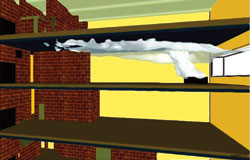 |
| MODEL Officials are skeptical about the validity of fire models used in performance design.(Graphic courtesy of ARUP) |
"Given the serious concerns we have regarding a structure of this height not having a dual lateral force-resisting system, we recommend against the designers proceeding with their proposed [performance-based] design. Instead, we suggest the designers follow code-prescribed methods."
That warning message in a May 5, 2004, letter from a San Diego building official to structural engineer Magnusson Klemencic Associates (MKA) was clear but all too familiar: Stop, turn around and follow the beaten path.
When it comes to official approvals for a nontraditional performance-based design (PBD), engineers can feel like turtles trying to make progress by sticking their necks out. Encountering hostile environments, they often retreat into their shells. When they do push on, they find the journey slow, arduous and risky. Anything outside the norm is "scary" for designers, who are liable, says Laurence Kornfield, a chief building inspector in San Francisco. But "its even scarier for civil servants," he adds. Though relieved of liability, "if something goes wrong on your watch, its a horrible feeling," says another building official.
PBD for commercial buildings, considered on the cutting edge of practice, marries defined demands with defined performance objectives through rigorous engineering. PBD for structural and fire protection engineering has become a hot topic, thanks to a quantum leap in relatively inexpensive computing power for modeling and analysis over the last decade. PBD, which can result in economies, efficiencies and innovation, "means going back to real engineering as opposed to prescriptive or cookbook engineering," says Ron Klemencic, president of MKA, Seattle.  Click here to view chart
Click here to view chart
Most often, engineers use PBD to enhance building performance beyond minimum standards for life safety set by codes. For example, one might want immediate occupancy of a building after an earthquake, to minimize a businesss economic losses. Other designers use PBD for unique geometries not addressed in the codes. And a few, MKA among them, use PBD to meet the prescriptive codes.
In the case of a 460-ft-tall building in seismic San Diego, MKAs motivation was purely economic. There, the code requires a building taller than 240 ft to have a dual lateral system, a core shear wall in combination with a moment frame, for example. That costs $4 to $5 per sq ft more than a single system. MKA thinks there is no "real rationale" behind the height limit. It hoped to use PBD to prove that and save the developer money.  Click here to view chart
Click here to view chart
It didnt get the chance, largely because U.S. codes do not address PBD. That puts PBD outside the comfort zone of most building code officials. "When you get...
